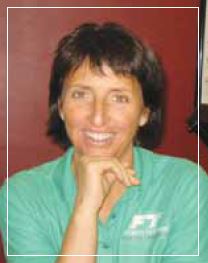Joint Alignment Matters
 by Paula Allia
by Paula Allia
PT, DHSc, MTC, OCS
Did you ever think about why some may be in their 30s and have arthritis in their knees yet another is 75 years old, a marathon runner with very little if any arthritis is present? What causes osteoarthritis and why do some people get it more than others? Let’s explore the causes and understand the various choices that one may have to counteract the dysfunctions and strains on the body.
Osteoarthritis is the most common type of arthritis caused by wear and tear on a joint. On the ends of bones where articulations occur there is a shiny surface that is called hyaline cartilage. Do not confuse this with cartilage that is also called a meniscus. This is another joint structure altogether. This hyaline cartilage gets bathed by joint synovial fluid and when healthy, stays shiny and smooth, allowing smooth sliding and gliding at the joint.
Provided that joint integrity is intact with normal alignment and proper muscle coordination around the joint, smooth functional movement allows one to function in a pain free manner. This is ideal for the active person.
There are several things that can cause weight bearing joints to breakdown. First, and injury can occur such as a fall, twist, or accident. Secondly, some people are born with a less than optimal alignment. Finally, participating in impact sports can all cause joint breakdown over the years.
An injury to a joint occurs more commonly with a quick motion, an unexpected step, a twist, or sudden fall. This type of injury puts strain on the joint’s components, particularly the ligaments and even the cartilage. Ligaments are essential with helping the joint maintain proper alignment. The meniscus (if there is one in the joint) acts to also protect the joint.
When either of these are injured the joint becomes compromised.
Unfortunately, some people are born with a malalignment. This predisposition may cause joint breakdown at an earlier age. Pain does not occur at the beginning of the breakdown. Everybody is different but one may actually have an altered gait but still not pain. As the hyaline cartilage wears, bone on bone rubbing causes the shiny articular surface to breakdown and once hitting the right threshold, pain ensues.
Alignment of the bones in a joint matter. In a perfect situation, proper joint alignment with muscles coordinating their efforts perfectly is ideal for function. Some are lucky to have this but many others are not. By middle age, many people have already sustained an injury to a joint even if it was normally positioned prior. Now what do you do?
If there are malalignments, the key to delaying continued progression of osteoarthritis is to lose weight if needed and choose the right exercise that did not exacerbate the condition.
It is important to understand that exercising is still very important. The problem is that many do not adapt themselves to the current alignment and condition of the joint. Thus, slow progressive inflammatory breakdown continues and eventually the pain threshold is reached. The gait changes, the body adapts to a newer posture and more breakdowns occur, sometimes to additional joints
because of the adaptations.
So what does one do? You want to keep moving? Well, first wearing shoes that have good shock absorption is essential. Many people in Florida wear sandals or non supportive shoes which does not support the ankle and foot. A foot and ankle that does not respond normally to the gait of walking or running can put more undue strain on the knee and hip and if there is a history of an injury with a biomechanical fault more stresses and strains will continue and further breakdown is eminent. The best scenario for success of continued activity, these are the recommendations:
- If overweight, take steps to change this
- If you have abnormal foot and ankle adaptation, consider and evaluation for orthotics to assist in proper weight transfer and propulsion
- Choose activities that do not put undue strain on the arthritic joint
- Maximize proper movement patterns and muscular control of the joints
- Consider bracing if needed for support
- Do not let your arthritis rule you…find out what you can do about it!
If you want further information please consider an evaluation to see what it good for you 239.263.9348.
To Your Health!

Leave a Reply
Want to join the discussion?Feel free to contribute!